oak rough bulletgall wasp
(Disholcaspis quercusmamma)
Conservation • Description • Habitat • Ecology • Distribution • Taxonomy
|
|
|||||||||||||
Description |
Oak rough bulletgall wasp is a cynipid gall wasp. It is usually identified by the gall it produces. In Minnesota, galls are found in clusters on the twigs and branches of bur oak and swamp white oak. They first appear as green bumps on the twig. The bumps later turn bright red. As they grow into round galls, they turn light brown and are soft. Eventually, they turn dark brown and harden. Mature galls are 5 ⁄16″ to ⅝″ in diameter, woody, and spherical, with a nipple-like, obscure point at the top. They produce honeydew that attracts bees, and wasps, and ants, which protect the gall wasp from other parasitic wasps. Each gall contains only a single wasp, though they may be shared by other species (inquilines). A small, circular hole in the side of a gall indicates where the wasp has emerged. The galls remain on the tree up to five years after the wasp has left the gall. They do not kill the host stem but will reduce the growth of the infested tree. |
Size |
Galls: 5 ⁄16″ to ⅝″ in diameter |
Similar Species |
Habitat |
Anywhere the host species are found |
Ecology |
Season |
One generation per year, late October to early November |
Behavior |
|
Life Cycle |
The life cycle of this wasp involves alternation of generations, one generation with only asexual females and one generation with both sexual males and sexual females. Information is only available for the asexual generation. The sexual generation has not been described in entomological literature. The female lays eggs in a dormant, terminal bud at the tip of a twig. In the late spring of the following year, the larva stimulates the growing stem to produce a gall in which the wasp develops. The larva pupates within a small cell in the center of the gall. In Minnesota, adults emerge in September. In the asexual generation, both winged and wingless females are produced. Males are unknown. |
Larva Hosts |
bur oak, swamp white oak |
Adult Food |
Adult wasps do not feed |
Distribution |
||
|
Sources |
|
| 3/23/2025 | ||
Occurrence |
||
Common |
||
Taxonomy |
|
Order |
Hymenoptera (Ants, Bees, Wasps, and Sawflies) |
Suborder |
Apocrita (narrow-waisted wasps, ants, and bees) |
Infraorder |
Proctotrupomorpha |
Superfamily |
Cynipoidea (gall wasps and allies) |
Family |
Cynipidae (gall wasps) |
Subfamily |
Cynipinae |
Tribe |
Cynipini (oak gall wasps) |
Genus |
Disholcaspis |
Subordinate Taxa |
|
|
|
Synonyms |
|
Disholcaspis mamma |
|
Common Names |
|
oak rough bulletgall wasp |
|
Glossary
Inquiline
An animal that lives in the nest of an animal of another species.
Visitor Photos |
||
Share your photo of this insect. |
||
This button not working for you? |
||
Alfredo Colon |
||
 |
||
 |
 |
|
Babette Kis |
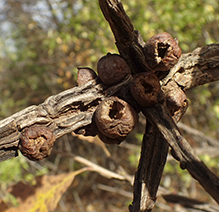 |
Oak rough bulletgall wasp Many galls on this particular bur oak, which was sapling size. |
MinnesotaSeasons.com Photos |
||
 |
||
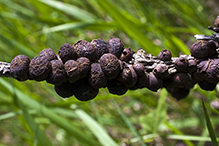 |
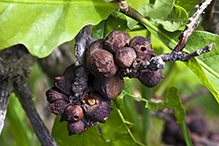 |
|
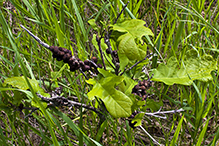 |
 |
|
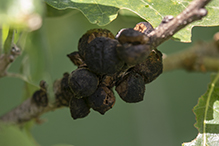 |
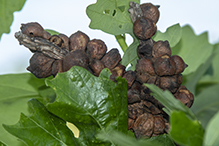 |
|
 |
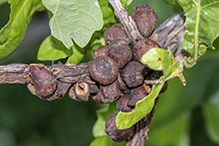 |

Slideshows |
|

Visitor Videos |
||
Share your video of this insect. |
||
This button not working for you? |
||
|
Other Videos |
||
Oak bullet galls & ants |
About
Aug 14, 2022 Oak rough bullet galls are formed on Swamp oak branches by the cynipid wasp Disholcaspis quercusmamma. The specific epithet referring to the "mammal-like" (breast-like) look. They also remind me of peaches, both by their red blush and the "fuzz". The gall tweaks the oak's programming to cause nectar production, which attracts Carpenter ants, who then patrol and feed. The enemies of the little larva inside each gall are then kept at bay by the ant guards. Potentially, the oak also benefits from the reduction of herbivory the ant's stewardship provides. Ants, cynipid wasps, and oak trees. (Apalachin Marsh, Apalachin, NY. August 2022, jcs.) |

Visitor Sightings |
||
Report a sighting of this insect. |
||
This button not working for you? |
||
Alfredo Colon |
Location: Albany, NY |
 |
Alfredo Colon |
Location: Albany, NY |
 |
| Babette Kis 10/13/2020 |
Location: hedgerow at Barnes Prairie, Racine Co., WI Many galls on this particular bur oak, which was sapling size. |
 |
MinnesotaSeasons.com Sightings |
||

Created 3/18/2019 Last Updated: © MinnesotaSeasons.com. All rights reserved. |
